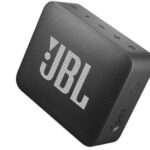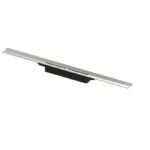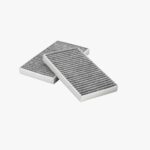VONROC TC501AC Tile Cutter User Manual
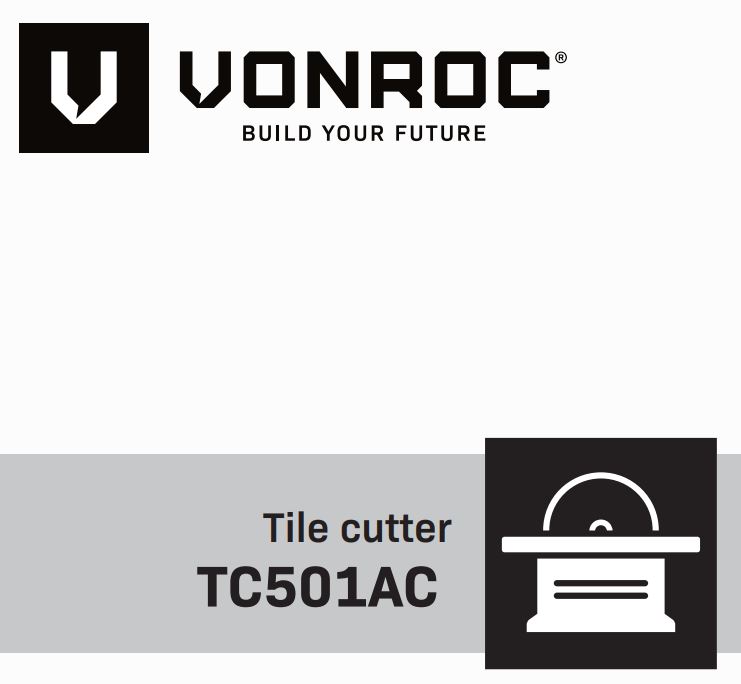
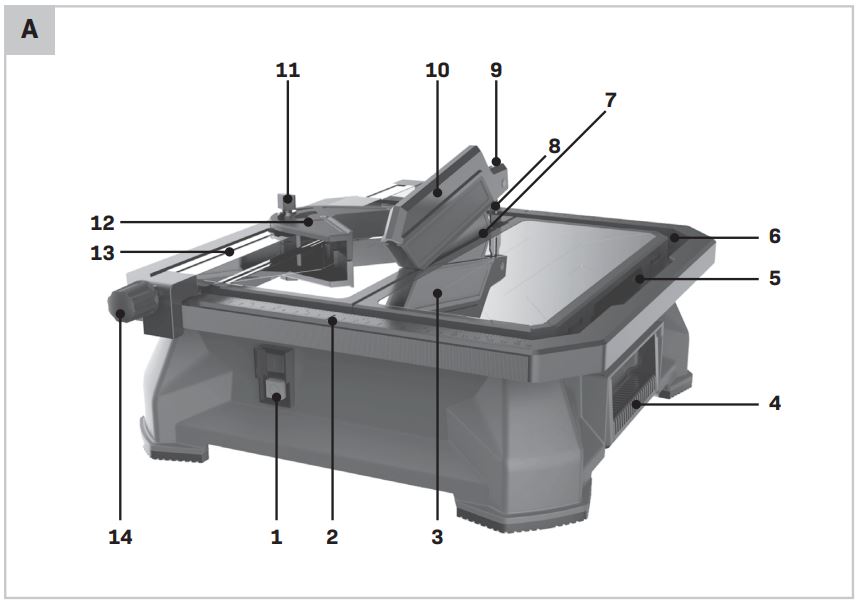
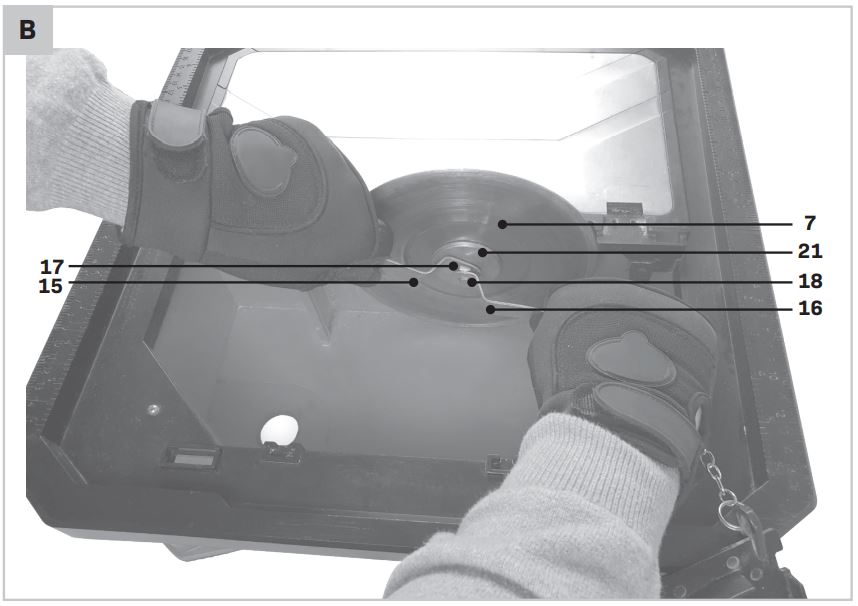
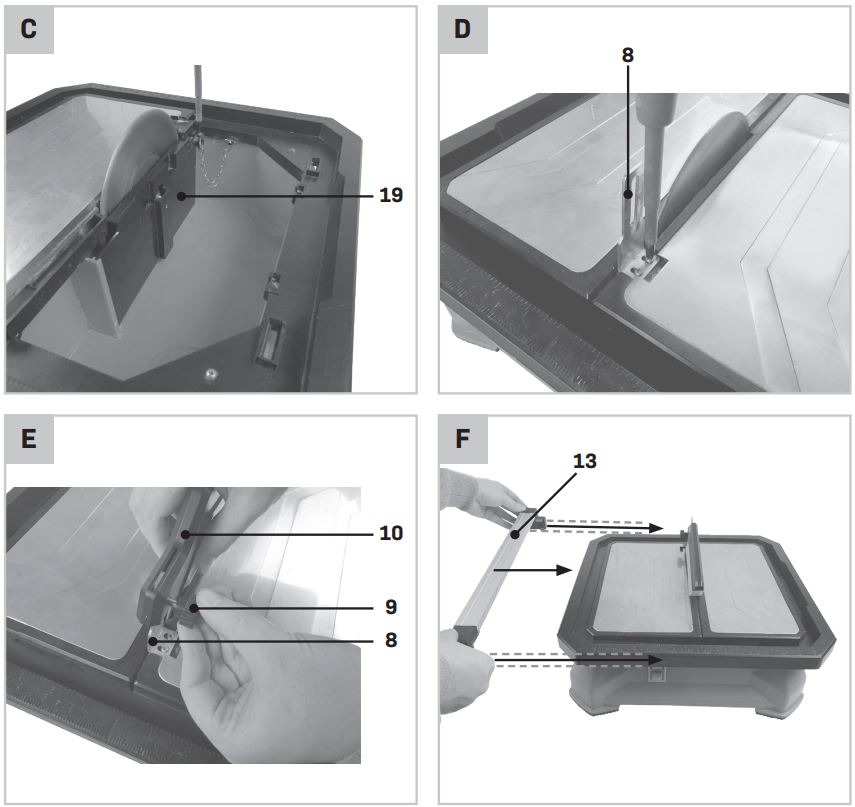
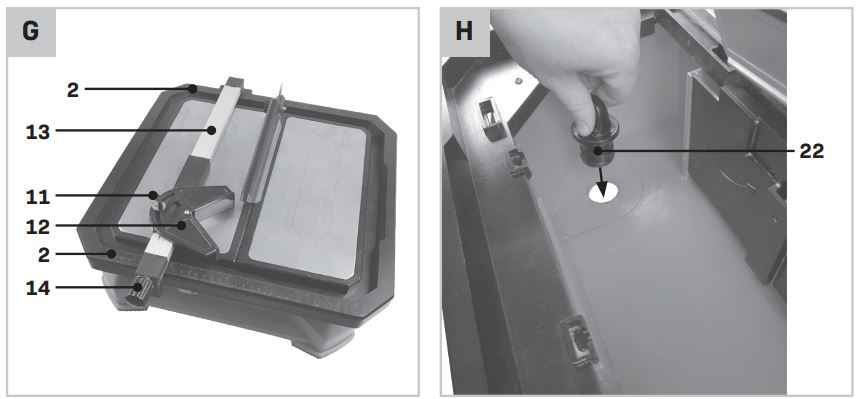
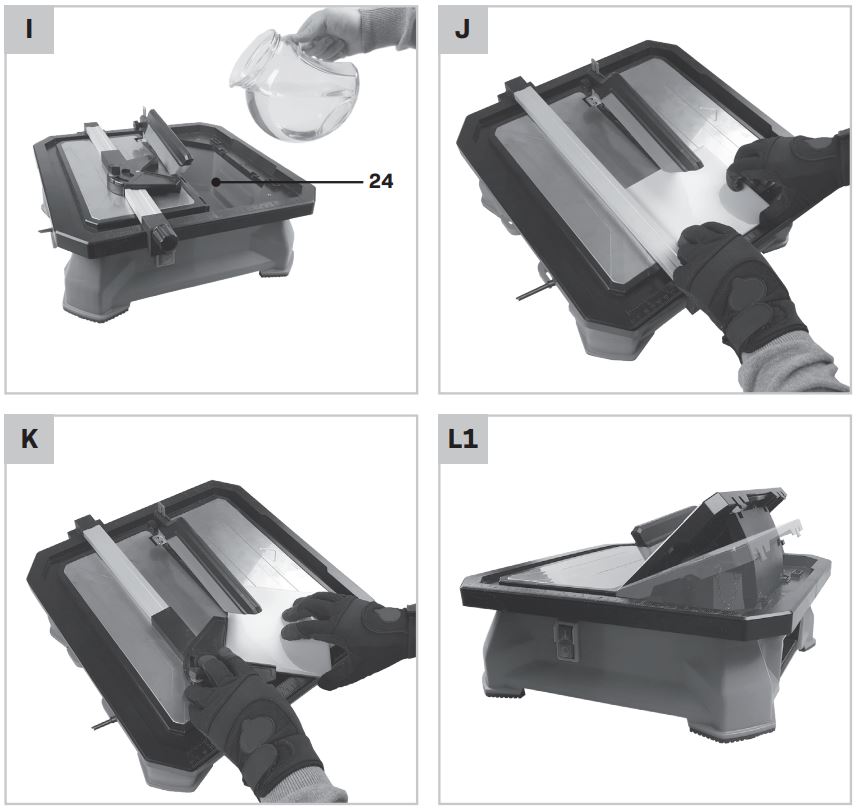
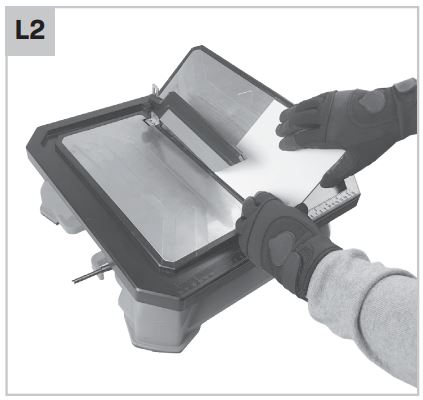
1. SAFETY INSTRUCTIONS
Read the enclosed safety warnings, the additional safety warnings and the instructions. Failure to follow the safety warnings and the instructions may result in electric shock, fire and/or serious injury. Save the safety warnings and the instructions for future reference.
The following symbols are used in the user manual or on the product:
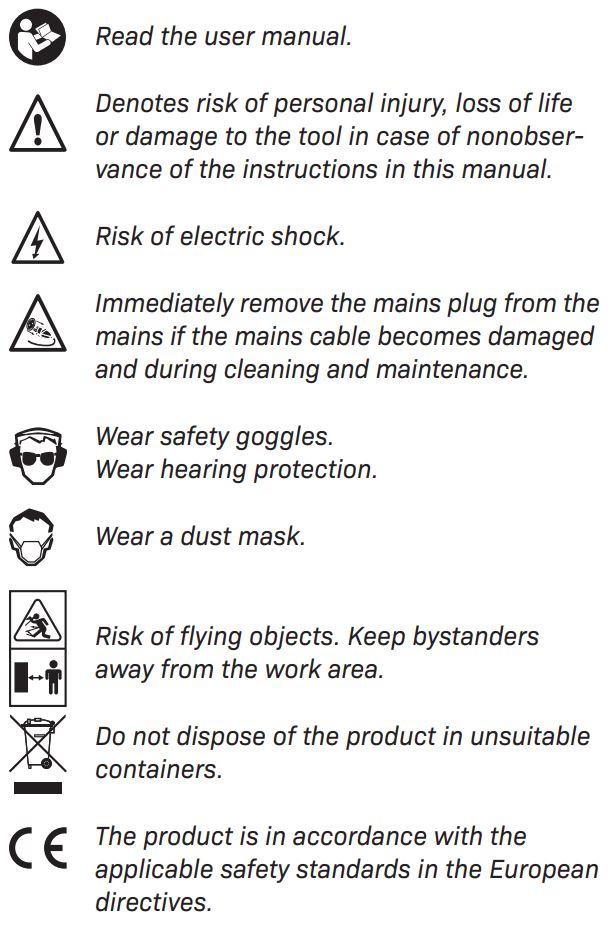
⚠ GENERAL POWER TOOL SAFETY WARNINGS WARNING! Read all safety warnings and all instructions. Failure to follow the warnings and instructions may result in electric shock, fire and/or serious injury.
Save all warnings and instructions for future reference. The term “power tool” in the warnings refers to your mains-operated (corded) power tool or battery-operated (cordless) power tool.
1) Work area safety
- a) Keep the work area clean and well lit. Cluttered or dark areas invite accidents.
- b) Do not operate power tools in explosive atmospheres, such as in the presence of flammable liquids, gases or dust. Power tools create sparks which may ignite the dust or fumes.
- c) Keep children and bystanders away while operating a power tool. Distractions can cause you to lose control.
2) Electrical safety
- a) Power tool plugs must match the outlet. Never
modify the plug in any way. Do not use any adapter plugs with earthed (grounded) power tools. Unmodified plugs and matching outlets will reduce risk of electric shock. - b) Avoid body contact with earthed or grounded surfaces, such as pipes, radiators, ranges and refrigerators. There is an increased risk of electric shock if your body is earthed or grounded.
- c) Do not expose power tools to rain or wet conditions. Water entering a power tool will increase the risk of electric shock.
- d) Do not abuse the cord. Never use the cord for carrying, pulling or unplugging the power tool. Keep cord away from heat, oil, sharp edges or moving parts. Damaged or entangled cords increase the risk of electric shock.
- e) When operating a power tool outdoors, use an extension cord suitable for outdoor use. Use of a cord suitable for outdoor use reduces the risk of electric shock.
- f) If operating a power tool in a damp location is unavoidable, use a residual current device (RCD) protected supply. Use of an RCD reduces the risk of electric shock.
3) Personal safety
- a) Stay alert, watch what you are doing and use common sense when operating a power tool. Do not use a power tool while you are tired or under the influence of drugs, alcohol or medication. A moment of inattention while operating power tools may result in serious personal injury.
- b) Use personal protective equipment. Always wear eye protection. Protective equipment such as dust mask, non-skid safety shoes, hard hat, or hearing protection used for appropriate conditions will reduce personal injuries.
- c) Prevent unintentional starting. Ensure the switch is in the off position before connecting to power source and/or battery pack, picking up or carrying the tool. Carrying power tools with your finger on the switch or energising power tools that have the switch on invites accidents.
- d) Remove any adjusting key or wrench before turning the power tool on. A wrench or a key left attached to a rotating part of the power tool may result in personal injury.
- e) Do not overreach. Keep proper footing and balance at all times. This enables better control of the power tool in unexpected situations.
- f) Dress properly. Do not wear loose clothing or jewellery. Keep your hair, clothing and gloves away from moving parts. Loose clothes, jewellery or long hair can be caught in moving parts.
- g) If devices are provided for the connection of dust extraction and collection facilities, ensure these are connected and properly used. Use of dust collection can reduce dust related hazards.
- h) Do not let familiarity gained from frequent use of tools allow you to become complacent and ignore tool safety principles. A careless action can cause severe injury within a fraction of a second.
4) Power tool use and care
- a) Do not force the power tool. Use the correct power tool for your application. The correct power tool will do the job better and safer at the rate for which it was designed.
- b) Do not use the power tool if the switch does not turn it on and off. Any power tool that cannot be controlled with the switch is dangerous and must be repaired.
- c) Disconnect the plug from the power source and/or the battery pack from the power tool be fore making any adjustments, changing accessories, or storing power tools. Such preventive safety measures reduce the risk of starting the power tool accidentally.
- d) Store idle power tools out of the reach of children and do not allow persons unfamiliar with the power tool or these instructions to operate the power tool. Power tools are dangerous in the hands of untrained users.
- e) Maintain power tools. Check for misalignment or binding of moving parts, breakage of parts and any other condition that may affect the power tool’s operation. If damaged, have the power tool repaired before use. Many accidents are caused by poorly maintained power tools.
- f) Keep cutting tools sharp and clean. Properly maintained cutting tools with sharp cutting edges are less likely to bind and are easier to control.
- g) Use the power tool, accessories and tool bits etc. in accordance with these instructions, taking into account the working conditions and the work to be performed. Use of the power tool for operations different from those intended could result in a hazardous situation.
- h) Keep handles and grasping surfaces dry, clean and free from oil and grease. Slippery handles and grasping surfaces do not allow for safe handling and control of the tool in unexpected situations.
5) Battery tool use and care
- a) Recharge only with the charger specified by the manufacturer. A charger that is suitable for one type of battery pack may create a risk of fire when used with another battery pack.
- b) Use power tools only with specifically designated battery packs. Use of any other battery packs may create a risk of injury and fire.
- c) When battery pack is not in use, keep it away from other metal objects, like paper clips, coins, keys, nails, screws or other small metal objects that can make a connection from one terminal to another. Shorting the battery terminals together may cause burns or a fire.
- d) Under abusive conditions, liquid may be ejected from the battery; avoid contact. If contact accidentally occurs, flush with water. If liquid contacts eyes, additionally seek medical help. Liquid ejected from the battery may cause irritation or burns.
- e) Do not use a battery pack or tool that is damaged or modified. Damaged or modified batteries may exhibit unpredictable behaviour resulting in fire, explosion or risk of injury.
- f) Do not expose a battery pack or tool to fire or excessive temperature. Exposure to fire or temperature above 130 °C may cause explosion. NOTE The temperature ,,130 °C” can be replaced by the temperature ,,265 °F”.
- g) Follow all charging instructions and do not charge the battery pack or tool outside the temperature range specified in the instructions. Charging improperly or at temperatures outside the specified range may damage the battery and increase the risk of fire.
6) Service
- a) Have your power tool serviced by a qualified repair person using only identical replacement parts. This will ensure that the safety of the power tool is maintained.
- b) Never service damaged battery packs. Service of battery packs should only be performed by the manufacturer or authorized service providers.
SPECIFIC SAFETY INSTRUCTIONS
- Check your power tool for damage before starting your work, particularly the diamond blade. All parts must be fitted properly and must meet all requirements in order to guarantee the tool’s smooth operation. Any safety guards or any lightly damaged parts must be checked to see if they still function properly before continuing the use of the tool. Moving parts, and the diamond-blade guard in particular, must be fitted properly and must not jam. Do not use tools that cannot be switched on or off with the switch.
- The diamond-blade guard must not be jammed or removed.
- A jamming guard must be repaired immediately.
- The riving knife must not be removed.
- The diamond blade must NEVER be exposed to sideways pressure; they can break and the flying pieces become projectiles!
- Do not attempt to cut extremely small pieces from the tiles. Always make sure that the full surface of the tile is on the work table. The supplied mitre guide can be used to push the tiles through the cutter. In the early stages of cutting in particular, the tile must remain absolutely level to avoid the tile moving up.
- Do not overload your tool. It is better and safer to work within the indicated power range. Do not cut materials other than tiles.
- Maintain your tools carefully. Keep the tools sharp and clean in order to work properly and safely.
- Follow the maintenance instructions and the instructions for replacing the diamond blade.
- Stand safely and maintain your balance. Avoid any unnatural body angles. Remain alert and pay attention to your work. Use common sense. Do not use the machine when you cannot concentrate or when you are tired.
- Cracked or distorted diamond blades must be replaced.
- Type of disk: a diamond blade with a diameter of 180mm.
- Do not use diamond blades that do not meet the specifications in these instructions.
- Ensure that the diamond blade is secured properly and rotates in the correct direction.
Electrical safety
When using electric machines always observe the safety regulations applicable in your country to reduce the risk of fire, electric shock and personal injury. Read the following safety instructions and also the enclosed safety instructions.
![]() Always check that the power supply corresponds to the voltage on the rating plate.
Always check that the power supply corresponds to the voltage on the rating plate.
Connecting to the power supply
Check that the power supply and plug used in accordance with tour tool. Have a look at the rating plate on the tile cutter. Any changes should always be carried out by a qualified electrician.
![]() Warning! This machine must be earthed.
Warning! This machine must be earthed.
If not properly earthed this machine can cause an electrical shock. Be sure that the power supply outlet is earthed. If there is any doubt, have it checked by a qualified electrician.
Warning! Avoid contact with the terminals on the plug when installing (removing) the plug to (from) the power supply outlet. Contact will cause a severe electrical shock.
Replacing cables or plugs
Immediately throw away old cables or plugs when they have been replaced by new ones. It is dangerous to insert the plug of a loose cable in the wall outlet.
Using extension cables
Only use an approved extension cable suitable for the power input of the machine. The minimum conductor size is 1.5 mm2. When using a cable reel always unwind the reel completely.
2. MACHINE INFORMATION
Intended use
This tool is suitable for cutting various wall and floor tiles. It is not permitted to use the tool for any other materials.
TECHNICAL SPECIFICATIONS

Vibration level
The vibration emission level stated in this instruction manual has been measured in accordance with a standardized test given in EN 62841; it may be used to compare one tool with another and as a preliminary assessment of exposure to vibration when using the tool for the applications mentioned.
– Using the tool for different applications, or with different or poorly maintained accessories, may significantly increase the exposure level.
– The times when the tool is switched off or when it is running but not actually doing the job, may significantly reduce the exposure level.
Protect yourself against the effects of vibration by maintaining the tool and its accessories, keeping your hands warm, and organizing your work patterns.
DESCRIPTION
The numbers in the text refer to the diagrams on page 2-4.
- On/Off switch
- Parallel guide scale
- Bevel table
- Transport handle
- Bevel table handle
- Table drain
- Cutting wheel
- Riving knife
- Guard knob
- Guard
- Miter guide knob
- Miter guide
- Parallel guide
- Parallel guide knob
- Hex wrench
- Spindle wrench
- Wheel nut
- Spindle
- Lower blade guard
- Inner wheel flange
- Outer wheel flange
- Overflow drain
- Max water fill line
- Water reservoir
3. ASSEMBLY
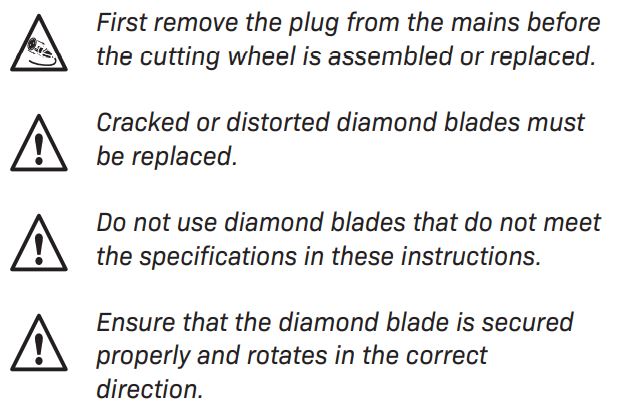
Mounting the cutting wheel (Fig. A, B & C)
- Pull the bevel table handle (5) and remove the bevel table (3).
- Loosen the screw holding the lower blade guard (19), as shown on figure C.
- Remove the lower blade guard (19).
- Put the hex wrench(15) on the wheel nut (17) and the spindle wrench (16) on the spindle (18). Loosen the nut with the wrenches, as shown on figure B.
- Remove the nut (17) and the outside flange (21) from the spindle (18).
- Mount the cutting wheel (7).
- Mount the outside flange (21) and afterwards add the wheel nut (17).
- Tighten the nut by using the wrenches.
- Now re-mount the lower blade guard (19) and fixate it by tightening the screw.
- Put the bevel table (3) back in place. Ensure the notches on the left side of the bevel table (3) align with the holes in the housing. Then press the table downwards, fixating the table.
Assembly of the riving knife (Fig. D)
- Unscrew the two (crosshead) screws and place the foot of the riving knife (8) on the table.
- Mount the riving knife (8) by tightening the two screws.
Installing the guard (Fig. E)
- Connect the guard to the riving knife (8) with the knob (9) and the locknut.
- Tighten the knob (9).
Replacing the cutting wheel (Fig. A, B & C)
- Pull the bevel table handle (5) and remove the bevel table (3).
- Loosen the safety guard’s knob (9) and remove the safety guard (10).
- Loosen the screw holding the lower blade guard (19), as shown on figure C.
- Remove the lower blade guard (19).
- Put the hex wrench(15) on the wheel nut (17) and the spindle wrench (16) on the spindle (18). Loosen the nut with the wrenches, as shown on figure B.
- Remove the nut (17) and the outside flange (21) from the spindle (18).
- Replace the cutting wheel (7).
- Mount the outside flange (21) and afterwards add the wheel nut (17).
- Tighten the nut by using the wrenches.
- Now re-mount the lower blade guard (19) and fixate it by tightening the screw.
- Put the bevel table (3) back in place. Ensure the notches on the left side of the bevel table (3) align with the holes in the housing. Then press the table downwards, fixating the table.
- Add the safety guard (10) on the riving knife (8) and tighten the knob (9).
Installing the parallel guide (Fig. F & G)
- Turn knob (14) on parallel guide (13) counter clockwise to loosen.
- Attach the parallel guide (13) from the side of the table as shown on figure F.
- Turn parallel guide knob (14) clockwise to tighten securely.
Installing the miter guide (Fig. G)
- Slide miter guide (12) onto parallel guide (13).
- Adjust parallel guide to (13) desired position and secure.
- Adjust to desired angle using angle scale and tighten securely with miter guide knob (11).
Installing the overflow drain (Fig. A & H)
- Pull the bevel table handle (5) and remove the bevel table (3).
- Push overflow drain (22) into hole firmly.
- Put the bevel table (3) back in place. Ensure the notches on the left side of the bevel table (3) align with the holes in the housing. Then press the table downwards, fixating the table.
Filling the water reservoir (Fig. A & I)
- Pull the bevel table handle (5) and remove the bevel table (3).
- Fill water reservoir (24) with clean tap until the maximum fill line, as indicated on the overflow drain (22).
- Put the bevel table (3) back in place. Ensure the notches on the left side of the bevel table (3) align with the holes in the housing. Then press the table downwards, fixating the table.
⚠ Be aware that the overflow drain prevents overfilling. Water will overflow when you fill water above the fill line.
Change reservoir water (Fig. A & I)
- Pull the bevel table handle (5) and remove the bevel table (3).
- Put the tile saw on a bucket.
- Remove overflow drain (22).
- Empty the reservoir (24) into the bucket.
- Re-mount the overflow drain (22).
- Put the tile saw on a stable surface, for example on the ground.
- Fill water reservoir (24) with clean tap water until the maximum fill line, as indicated on the overflow drain (22).
- Put the bevel table (3) back in place. Ensure the notches on the left side of the bevel table (3) align with the holes in the housing. Then press the table downwards, fixating the table.
4. OPERATION
⚠ Before starting the job, please ensure there is sufficient water in the water reservoir (24) i.e. the diamond blade must runs through the water. During the job, the water reservoir must be topped up.
⚠ Do not start working before the maximum speed has been reached.
⚠ The diamond blade must NEVER be exposed to sideways pressure; they can break and the flying pieces become projectiles!
⚠ Always keep the mains cable away from moving parts.
Switching on/off (Fig. A)
- Press the switch (1) into position `1′ to put your machine into operation.
- To switch off the machine the same switch (1) needs to be pressed to position `0′
Straight cuts (Fig. A & J)
The parallel guide (13) enables you to cut parallel to the cutting blade and make straight cuts.
- Loose the knob (14) and set the required distance.
- Tighten the knob (14).
- Position the tile on the table top.
- Press the switch (1) into position `1′ to put your machine into operation.
- Maintain an even pressure, hold the tile against the cutting guide and push steadily through the cutting wheel.
- When the cut is complete, you can switch (1) off the machine.
Mitre cut (Fig. A & K)
Mitre 0-45° cuts can be made using the mitre guide (12).
- Slide the mitre guide (12) into place on the parallel guide (13).
- Loose the knob (11) and set the required angle.
- Tighten the knob (11).
- Position the tile within the jaws of the mitre guide (12).
- Press the switch (1) into position ‘1’ to put your machine into operation.
- Push the mitre guide (12) steadily along the parallel guide (13), feeding the tile through the cutting wheel (7).
- When the cut is complete, you can switch (1) off the machine.
Bevel cut (Fig. A & L)
Beveled 22.5° and 45° cuts can be made by adjusting the angle of the bevel table (3).
- Pull the bevel table handle (5).
- Raise the bevel table (3) to the required angle, as shown on figure L1.
⚠ Make sure bevel table is locked firmly in place before beginning cut. - Position the tile on the bevel table (3), as shown on figure L2.
- Press the switch (1) into position `1′ to put your machine into operation.
- Maintain an even pressure, hold the tile against the cutting guide and push steadily through the cutting wheel (7).
- When the cut is complete, you can switch (1) off the machine.
Transporting the tile cutter (Fig. A & I)
Before transporting the tile cutter, the following steps must be carried out:
- Pull the mains plug.
- Remove all accessories that cannot be mounted firmly to the power tool.
- Wind the mains cable and bind it.
- Remove bevel table (3).
- Put the tile saw on a bucket.
- Remove overflow drain (22).
- Empty the reservoir (24) into the bucket.
- Replace overflow drain (22).
- Put the tile saw on the ground.
- For lifting or transport, use the transport handle
5. MAINTENANCE
Before cleaning and maintenance, always switch off the machine and remove the mains plug from the mains. Clean the machine casings regularly with a soft cloth, preferably after each use. Make sure that the ventilation openings are free of dust and dirt.
Remove
very persistent dirt using a soft cloth moistened with soapsuds. Do not use any solvents such as gasoline, alcohol, ammonia, etc. Chemicals such as these will damage the synthetic components.
ENVIRONMENT
![]() Faulty and/or discarded electrical or electronic apparatus have to be collected at the appropriate recycling locations.
Faulty and/or discarded electrical or electronic apparatus have to be collected at the appropriate recycling locations.
Only for EC countries
Do not dispose of power tools into domestic waste. According to the European Guideline 2012/19/EU for Waste Electrical and Electronic Equipment and its implementation into national right, power tools that are no longer usable must be collected separately and disposed of in an environmentally friendly way.
WARRANTY
VONROC products are developed to the highest quality standards and are guaranteed free of defects in both materials and workmanship for the period lawfully stipulated starting from the date of original purchase. Should the product develop any failure during this period due to defective material and/or workmanship then contact your VONROC directly.
The following circumstances are excluded from this guarantee:
- Repairs and or alterations have been made or attempted to the machine by unauthorized service centres;
- Normal wear and tear;
- The tool has been abused, misused or improperly maintained;
- Non-original spare parts have been used.
This constitutes the sole warranty made by company either expressed or implied. There are no other warranties expressed or implied which extend beyond the face hereof, herein, including the implied warranties of merchantability and fitness for a particular purpose. In no event shall VONROC be liable for any incidental or consequential damages.
The dealers remedies shall be limited to repair or replacement of nonconforming units or parts.
The product and the user manual are subject to change. Specifications can be changed without further notice.
![]() DECLARATION OF CONFORMITY TC501AC – TILE CUTTER
DECLARATION OF CONFORMITY TC501AC – TILE CUTTER
We declare under our sole responsibility that this product is in conformity with directive 2011/65/EU of the European parliament and of the council of 8 June on the restriction of the use of certain hazardous substances in electrical and electronic equipment is in conformity and accordance with the following standards and regulations:
EN62841-1, EN55014-1, EN55014-2, EN61000-3-2, EN ISO 12100, EN 61000-3-3, 2006/42/EC, 2014/30/EU, 2011/65/EU, 2012/19/EU
Zwolle, 01-12-2021

H.G.F Rosberg
CEO
VONROC • Lingenstraat 6 • 8028 PM Zwolle • The Netherlands

©2021 VONROC
WWW.VONROC.COM
2112-28
Download PDF
VONROC TC501AC Tile Cutter User Manual PDF Download


